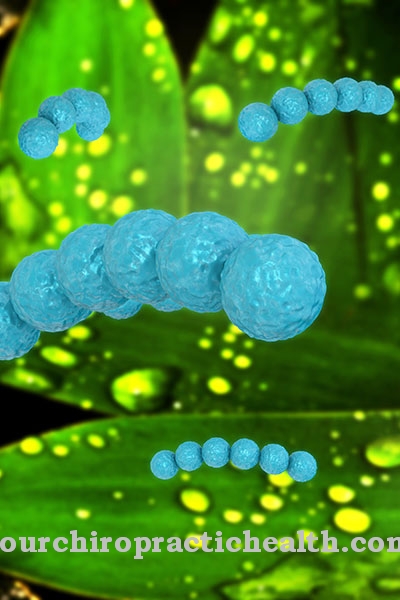A Scleritis is an inflammation of the dermis (sclera) of the eye, which, if left untreated, can cause a loss of vision. The age peak of the disease is between 40 and 60 years of age, with women being affected significantly more often than men.
What is scleritis?

© Copyright - stock.adobe.com
As Scleritis is a diffuse or localized inflammation of the dermis, which in many cases has a chronic course with recurrences (40 percent). Different forms of scleritis are differentiated depending on the location and course.
If the inflammation is in the front area or in front of the eyeball equator, it is an anterior scleritis, while a focus of inflammation in the rear area or behind the eyeball equator is referred to as scleritis posterior. In addition, anterior scleritis is divided into necrotizing forms with whitish necrosis areas, diffuse scleritis, which usually affect the eyeball in sectors, and nodular subtypes with movable reddish-blue nodes.
As a result of the inflammation, edematous (fluid storage) swellings of the dermis manifest themselves with pronounced pressure pain in the affected eye, which in combination with eyelid edema and chemosis can cause visual impairment. The pressure pain characteristic of scleritis can radiate into the affected half of the face.
causes
The cause of one Scleritis cannot be clarified in many cases (idiopathic scleritis). In around 50 percent of cases, the disease can be associated with systemic underlying diseases such as rheumatic impairments (including collagenoses such as periarteritis nodosa or lupus erythematosus, rheumatoid arthritis), Crohn's disease, gout or autoimmunological diseases.
Scleromalacia perforans (necrotizing scleritis) in particular is often associated with severe rheumatoid arthritis. Infectious diseases such as tuberculosis, herpes zoster or syphilis can also cause scleritis.
In some cases, keratitis (inflammation of the cornea) or iridocyclitis (inflammation of the iris with involvement of the ciliary body) can also cause secondary inflammation of the dermis. Rarely, scleritis is iatrogenically caused by medical intervention.
Symptoms, ailments & signs
Scleritis initially manifests itself as typical signs of inflammation such as redness, pain and itching in the area of the affected eye. The characteristic feature is constant tearing in the affected eye, combined with visual disturbances such as blurred vision or double vision, whereby the disturbances are not very pronounced and usually pass quickly.
As a result of the inflammation and the persistent flow of tears, a swelling forms, which can be seen externally. In addition, there may be reddish-blue lumps in the area of the eye. In addition, visual acuity can temporarily decrease if the symptoms are related to eyelid edema or chemosis.
In severe cases, scleritis can lead to the development of staphylomas. Often scars form or permanent vision impairment occurs. Symptoms of scleritis appear within a few hours to days. Typically, a visible reddening occurs shortly after the triggering event.
Then the characteristic swelling sets in, accompanied by a sudden decrease in vision. If the condition is treated directly, the symptoms usually go away quickly. Untreated scleritis can be chronic and in the worst case lead to blindness in the affected eye.
Diagnosis & course
The diagnosis is made by a Scleritis usually on the basis of the symptoms characteristic of the disease, in particular on the basis of the pronounced pressure pain. As part of the physical examination with the slit lamp, a thickening of the sclera in the slit image can be determined due to the swollen scleritic area.
In addition, the extent of the inflammation and the clinical form of the scleritis can be determined using the slit image. The changes in the sclera can be visualized by sonography (ultrasound). In the differential diagnosis, scleritis must be differentiated from conjunctivitis and corneal inflammation as well as episcleritis.
In addition, if scleritis is confirmed, a possible systemic underlying disease should be checked. The prognosis and course of scleritis strongly depend on the specific form. For example, those affected with anterior diffuse scleritis (9 percent) have a much lower risk of loss of vision than those with nodular (25 percent), necrotizing (75 percent) or posterior scleritis (80 percent). Underlying autoimmune diseases also have an unfavorable effect on the prognosis.
Complications
In some cases, scleritis may be related to inflammation of the cornea or iris. This can make the original complaints worse. The edema and swelling can become inflamed and cause further complications. In extreme cases, the infection spreads to other parts of the body.
Very rarely - for example, if the patient is already weakened due to another illness - blood poisoning can occur, which can be fatal. With long-term illnesses, the eye pain can also cause psychological problems. The same applies to visual disturbances, which are often extremely stressful for young patients. Scleritis therapy is usually symptom-free.
However, anti-inflammatory drugs, anti-inflammatory drugs, and other drugs that are commonly prescribed can cause side effects and interactions. Occasionally there are allergic reactions or an existing intolerance causes symptoms. The usual complications can occur during surgical intervention: bleeding, secondary bleeding and infections.
If the course is severe, there may, in rare cases, be loss of vision. Wound healing disorders may occur after the operation. In addition, scars often develop, which can be associated with pain and a feeling of pressure in the area of the procedure.
When should you go to the doctor?
Medical treatment is required for scleritis. In the worst case, if left untreated, the person affected will suffer a complete loss of vision, which is usually irreversible. For this reason, a doctor should always be consulted immediately with scleritis. A doctor should be consulted if the person concerned has severe reddening or severe itching of the eye. This leads to a severe inflammation of the eye, which does not go away on its own.
In general, sudden visual problems indicate scleritis and should be evaluated by a doctor if they occur for no particular reason. In many cases, those affected also suffer from double vision or veiled vision and can no longer cope with everyday life.
If these symptoms occur, the person affected should consult an ophthalmologist. Further treatment depends on the severity of the scleritis, so that no general prognosis can be given.
Treatment & Therapy
The therapeutic measures are based on one Scleritis the specific underlying disease and aim to reduce the symptoms. Systemically, to reduce symptoms, non-steroidal anti-inflammatory drugs or anti-inflammatory drugs such as flurbiprofen or indomethacin are usually used, which are administered orally and gradually tapered off over a period of several months (gradual reduction of the drug dose).
The individual pain can support the determination of the appropriate dose, as this serves as an indicator of the extent of the inflammatory activity. Acute inflammations can be systemically treated with corticosteroids (including prednisolone) in the case of pronounced pain. If this medication is ineffective or if there are pronounced side effects, the therapy can be adjusted and non-steroidal immunosuppressants such as cyclosporine A, methotrexate or azathioprine can be used.
In the case of necrotizing scleritis, immunosuppressants (especially cyclophosphamide) and initially orally or intravenously administered steroids are used as standard. Non-steroidal anti-inflammatory drugs are recommended for people with rheumatoid arthritis and diffuse or nodular scleritis, but methotrexate may be used for nodular scleritis.
If there is progressive necrotization of the sclera with an increased risk of eyeball perforation, surgical intervention (scleral transplantation) with peri- or postoperative immunosuppressive therapy is indicated. In addition, possible concomitant infections of scleritis should be treated with antibiotics (bacterially induced) or cold pads and / or synthetic tears (virally induced).
prevention
One Scleritis can be prevented through consistent and adequate therapy of the rheumatic, autoimmunological or infectious underlying diseases. On the other hand, there are no prophylactic measures against idiopathic scleritis due to the unknown etiology.
Aftercare
Those affected with scleritis usually have only a few and only limited follow-up measures available. For this reason, the patient should consult a doctor at the first symptoms and signs of the disease so that further complications can be prevented. As a rule, independent healing cannot occur, so that the person affected is usually always dependent on a medical examination and treatment.
The earlier a doctor is consulted, the better the further course of the disease usually is. This disease does not require permanent treatment, although regular checks and examinations by a doctor are very important. The kidneys and urinary tract in particular should be checked regularly.
Regular blood tests should also be carried out. In some cases, scleritis can cause infection or inflammation of the urinary tract or kidneys, so treatment with antibiotics is necessary. Regular medical checks are also very important. If the disease is treated by surgery, the person affected should take it easy after the operation and especially protect the affected area.
You can do that yourself
In the case of scleritis, medical treatment is required first. In addition, a whole range of self-help measures can be taken to support drug or surgical treatment and thereby contribute to a rapid recovery.
First of all, it is important to treat the individual symptoms for yourself. With reddened skin and infections, pads and cooling help. If necessary, diet can reduce the stress on the skin. It is advisable to avoid dairy products and spicy foods. Alcohol and nicotine are also considered harmful and should be avoided. Any accompanying infections are treated with cold pads. In consultation with the doctor, so-called synthetic tears can also be used. Treatment with the strong active ingredient must always be carried out under medical supervision in order to avoid complications and to be able to clarify queries quickly.
Scleritis is a serious disease that is associated with various symptoms and ailments.Home remedies and self-help measures can support medical therapy, but not replace it. If the tips mentioned do not bring any improvement, the family doctor must be informed so that the medical treatment can be adjusted.

.jpg)


.jpg)

.jpg)





.jpg)



.jpg)










.jpg)
